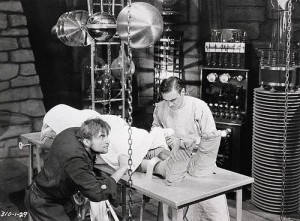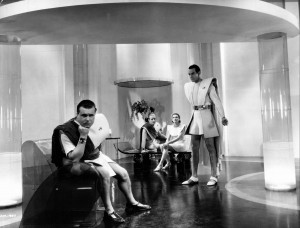So here’s the next in my continuing essay series. Before I dig into the two films and my arguments for selecting theme, let me talk for a couple of moments about definitions.
Science-Fiction is the genre of literature in which a development, advance, or change in scientific knowledge is critical to the plot, and that the removal of that elements renders the plot impossible.
Influential I touched on lightly in the first essay, but I want to expand here by detailing who and what is influenced. I am not speaking about the general public at large, thought that will nearly always be true as well, but that these films I have selected had an outsize impact on future filmmakers, often for generations.
So let’s get into the next decade, the 1930s.
My first selection is a well-known film, a classic know by huge numbers of people around the world;
 Frankenstein – 1931 – James Whale
Frankenstein – 1931 – James Whale
Certainly this tale has been around a hell of a lot longer than this 1931 film from Universal Studios. The novel by Mary Shelley was published in 1818 and has been adapted to stage and screen many times. In fact the 1931 production was not the first. Thomas Edison made a short based upon the novel (And knowing the man I’m willing to bet no royalties were paid,) that featured a creation scene done with a paper-mache monster burned to ash and run in reverse.
However it was James Whale and Universal’s Frankenstein that set the tone and standard for so many films to follow. It is unquestionably a science-fiction film because Dr. Frankenstein explains about visible rays, X-rays, and his discovery of a ray that generates all life. It is harnessing this ray, not sheer electrical power that revitalizes the monster’s corpse-like construction. This film is the granddaddy of all mad scientist movies. The lone inventor/scientist, working in some ruined, desolate, and gothic locale, that’s this Frankenstein and through this film German Expressionism. This is a film that continues to be referenced years and decades later, inspiring filmmakers to this day.
 Things to Come – 1936 – William Cameron Menzies
Things to Come – 1936 – William Cameron Menzies
This is a film that is not very well known outside of genre fans, but it is a critical film in the history of science-fiction movies, Based up the works of and with screenplay by H.G. Wells, this movie was a serious attempt to peer ahead and not only see what may be possible but also explain how we move from the present day to that fictionalized future. These days that is old hat in Science-Fiction films, but with this movie it was fairly revolutionary. Metropolis never explains where the city is, how it came to be, but merely waves it into existence and sets the story in motion. H.G. Wells, always the historian, loved plotting about the connecting dots between his times and his imagined futures; in effect he created the concept of the future history. Movies ever since Things To Come, if they were set in the future, have felt a pressure to explain how that future arrived. Things to Come was also the first post-apocalyptic movie and many to the tropes and plot devices of that genre were first established here. Two final aspects that influenced film making for decades, Things to Come gave us the clean art-deco city of the future that lasted all the up to Logan’s Run, and it gave the idea that people in the future would wear terribly silly fashions.

